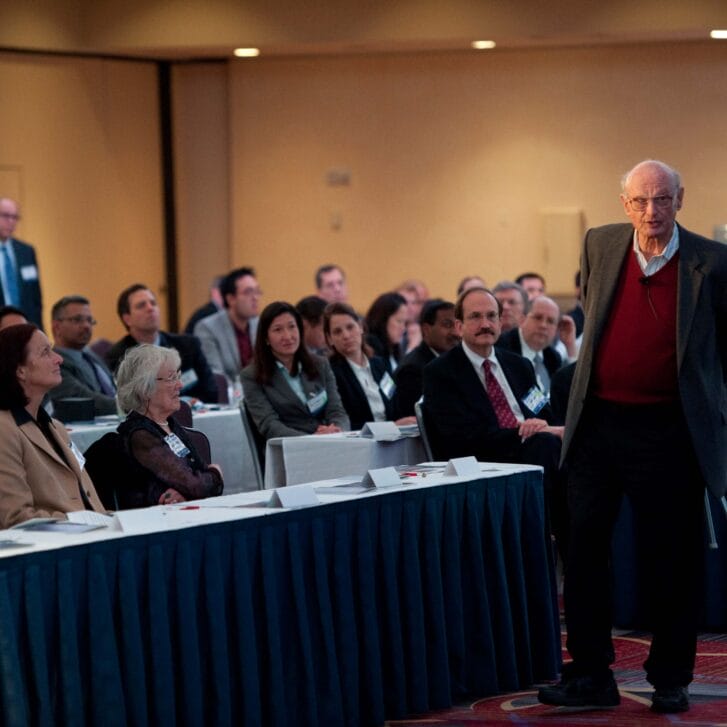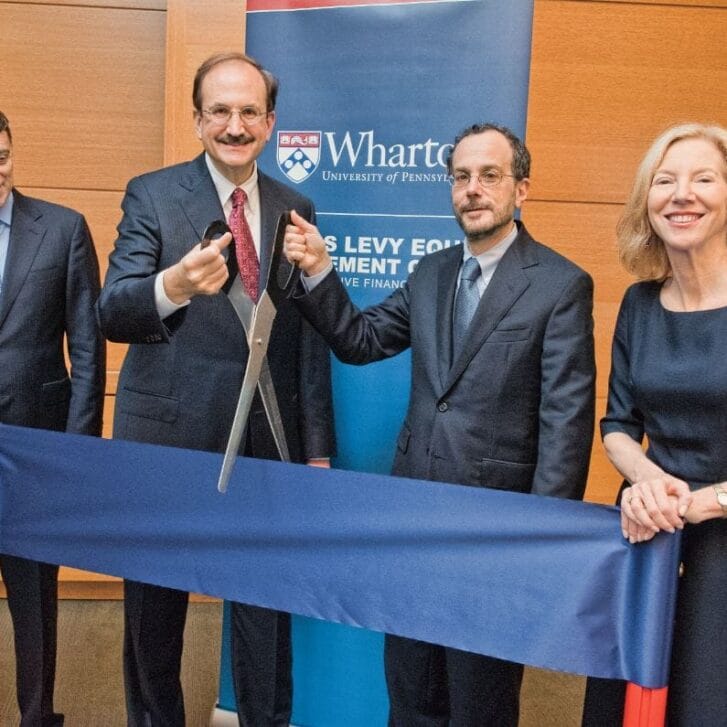World T.E.A.M. Sports, a non-profit organization that tries to pair disabled and non-disabled athletes for unique sporting events, was at a crossroads. Its executive director since the organization’s founding 12 years before, Stephen Whisnant, was leaving for a new job and, with many of the board members living in and around Boston, the board had decided to move the organization from Charlotte to Boston.
Those board members include such luminaries as pro bike racer Greg LeMond, former world champion distance swimmer Diana Nyad, and Thomas Kenny, managing director of Goldman, Sachs & Company, not to mention its founder, Jim Benson, the President and CEO designate of John Hancock. The organization had never really had to search for an executive director before, and it was determined to do that search right.
“Non-profits have a unique set of challenges, talent, and paradigms. It isn’t exactly like a for-profit company’s search,” said Willis J. Hulings III, WG’85, a World T.E.A.M. Sports director and private investor in Boston. “You turn a search over to a general firm and they are used to getting larger fees, based on salary. You have to wonder if they are interested.”
World T.E.A.M. Sports sponsors events like the Face of America Ride, where it gathered people affected by the 9/11 tragedy to bicycle from Ground Zero to Washington. “We tend to be an experiential philanthropy, much of which is funded by our directors,” said Hulings. “We needed someone who understood and was enthusiastic about that sort of commitment, but someone who also had business sense.”
Hulings had heard of a new firm, Bridgestar, a spinoff of the global business consultants Bain & Company, whose managing partner, David Simms, was a fellow Wharton graduate.
“I went to a presentation, and they really seemed to have it all together, to have the spirit of what a non-profit was all about,” said Hulings. Within weeks, Hulings and other board members were interviewing what he felt were top-notch candidates, and a couple of months later, World T.E.A.M. Sports had hired its new executive director, Chris Carigg, a former director of the tennis program of the Massachusetts Special Olympics.
“We were looking for someone committed to the world of non-profits, someone with former experience, and someone who wanted to be in Boston,” said Hulings. “It was going to be really difficult for the directors themselves to come up with that, but the people at Bridgestar knew the way to go about it. I applaud their taking the initiative to move into a sector like this.”
Simms himself had been looking for a mission in the non-profit world when he helped found Bridgestar last year. He had himself been a bit of a “bridger,” going back and forth a few times between the profit and non-profit world. After graduating from Wharton’s dual-degree undergraduate and engineering program in 1979, he went on to another joint-degree program, Harvard University’s JD/MBA.
“I took the usual path and got a good job with Bain,” he said “It was a chance to use my skills in a way that gave me an opportunity to see a lot of different industries and work with a bright and talented group of people. Who wouldn’t want to do that?”
Despite mostly working with for-profit companies, Simms still had the desire to do more public service. A mentor at Bain, William Hamilton, directed him to the White House Fellows program, and Simms spent the 1988-89 year working for John Whitehead, a deputy secretary of state in the Reagan Administration, and his successor in the first Bush presidency, Lawrence Eagleberger.
“It was a huge piece of education. I got to see how public policy worked, and that is really the basis of where I come to in Bridgestar,” said Simms. After his White House Fellowship, Simms stayed in Washington, first running his own marketing and consulting firm and then bridging back again to the non-profit sector as Chief Executive Officer of the Red Cross Blood Services Washington region. “I was seeing both sides, and knew non-profits needed a special kind of person who was different than the kind of person who runs a for-profit entity.”
Fortunately, his old firm, Bain and Company, had this idea in mind, too. It was looking for a way to expand its consulting services in the non-profit area, one clearly not as lucrative as for-profit consulting, but an area in which Bain thought it could differentiate itself from the other top consulting concerns. After a three-year study, Bain started The Bridgespan Group in 2000 to specialize in consulting for non-profits. But even after that, Bridgespan decided it was doing well in non-profit strategy, but not enough to search out those who could implement that strategy — the top executives and board members to run those non-profits.
So Simms became the managing partner of Bridgestar, challenged with finding a community of sorts of non-profit executives and board members — something, Simms said, that has been mostly unaddressed by traditional search firms and consultants.
“It’s important to understand the dynamics of what is the same and what is different in for-profit and non-profit businesses,” said Simms. “You’re running a dual-mission environment in non-profits. Why people work there in the first place is mission-centric. Basically, it is, ‘How do I make the world a better place?’ The mission is the force and energy behind the organization. People want to find a way to make something or do something socially significant. But you can’t deny that financials are a necessary piece of this, yet not in the worrying about quarterly-over-quarterly results.”
Simms said that lots of consulting firms did a good job of helping non-profits with strategy. Even though there was not as much revenue coming in on every contract with non-profits, the consulting firms were willing to deal in strategic planning, especially when a non-profit had its leadership team in place.
But when it came to looking for people to run non-profits or to take seats on boards, they fell short. For the most part, said Simms, they are used to looking at cadres of people from the for-profit world who are, first, more interested in guiding the affairs of a more bottom-line business. Further, the salaries of for-profit leaders are so much higher that the fee the traditional search firm makes on finding a prospect there is much greater.
So Bridgestar took the unusual tact of forming as a non-profit itself. It’s not that money doesn’t matter, said Simms, but it at the very least put Bridgestar’s mission in perspective.
“Those of us who have transitioned from Bain now live and breathe the non-profit world,” he said. “We see our strength as being part of the community we are trying to form.”
Bridgestar has assembled non-profits of many stripes, like World T.E.A.M. Sports, to be on its roster. Then it has done recruiting and seminars just to sign executives, board members, and universities up as references and, sometimes, potential employers or employees. Wharton was one of the first to become part of the Bridgestar network.
“We are very supportive of Bridgestar’s mission,” said Peter Degnan, Wharton’s director of MBA Career Management. “The initial audience will be alumni with experience, either as CEOs, COOs or CFOs, or board members of these organizations.
“But we have seen a growing interest in the not-for-profit world here in recent years,” said Degnan. A growing number of students graduating from Wharton are pursuing roles in this field, and around five percent of the School’s 2005 graduates took summer internships in the non-profit world. “They are not simply going to work for consulting firms without giving this greater thought. The Net Impact Club has about 100 members, and that is a very good indicator of people looking in the non-profit world. Bridgestar will help educate everyone that Wharton has this base of talent, and likewise it will help us educate students who want to go into that world.”
Simms has already visited campus, not to recruit for any particular organization, but to excite students about working in the non-profit world.
“When you think about what a venture capitalist does for the for-profit business, well, that is what I am hoping to do for non-profits,” said Simms. “They look for strong talent to bring an idea to fruition. I want to take that talent dimension and add passion for a cause to it to create stronger non-profits.”
Despite Bridgestar’s success so far with organizations like World T.E.A.M. Sports, Simms knows he isn’t fooling himself. Not everyone is going to want to be a non-profit leader or even want to bridge up and back between the two worlds, nor should they, he said.
“I wouldn’t say that it is something everyone should even want, let alone be able to do,” he said. “You have to look at the skill sets necessary to thrive and survive in the non-profit world.
“First, it is a resource-constrained environment. The availability of people and dollar resources are severely limited compared to for-profits,” he said. “You have to be able to roll up your sleeves and want to make a difference. You need huge communications skills and the ability to work in a collegial environment, which is not always necessary in a for-profit. You have a lot more stake-holders in your office, people with passion, large boards of directors, volunteers, all who really care about the mission. It’s not just workers looking for a paycheck. There is a high bias towards action and pressure to have results without a huge bankroll.
“So it really takes a different kind of person to run a non-profit. It takes a really different temperament, so a whole different set of skills than for-profit leaders,” he said. “But you still have to know business and that is where we hope our relationship with Wharton and other business schools, and with Bain, makes Bridgestar effective.”
Simms has put himself on a difficult schedule. He commutes to Bridgestar’s Boston headquarters at least three days a week from his home in Newtown Square, west of Philadelphia. He lives there with his wife of 21 years, Kim, and sons Stephen, 14, and Ryan, 11.
“In a way, that is part of the passion of a non-profit life,” he said. “It is good for our family to be there, so we make it work.”
If there is one piece of advice he would give to non-profits, though, about looking for good executives and board members, it would be take time doing so.
“The mission is so important to a non-profit that you can’t afford to have the wrong person guiding it,” he said. “Get a good interim person, perhaps a board member with some extra time, and then slow down. We need organizations with fabulous missions and we need the right people to guide them.”
For more information on Bridgestar, visit http://partners.bridgestar.org.

























